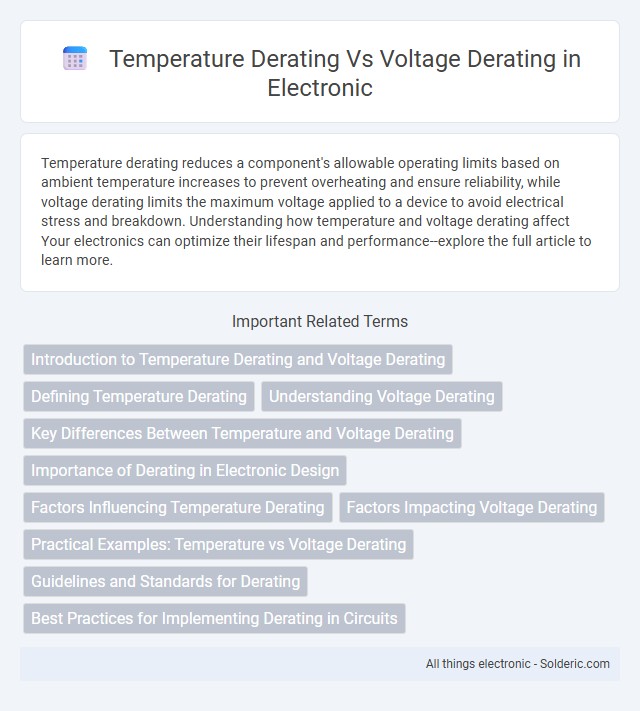Temperature derating reduces a component's allowable operating limits based on ambient temperature increases to prevent overheating and ensure reliability, while voltage derating limits the maximum voltage applied to a device to avoid electrical stress and breakdown. Understanding how temperature and voltage derating affect Your electronics can optimize their lifespan and performance--explore the full article to learn more.
Comparison Table
| Aspect | Temperature Derating | Voltage Derating |
|---|---|---|
| Definition | Reducing component rating as ambient temperature increases | Reducing component rating as applied voltage approaches maximum limit |
| Purpose | Prevent overheating and ensure reliability | Prevent electrical overstress and breakdown |
| Common Components | Resistors, capacitors, semiconductors | Capacitors, diodes, transistors, insulation materials |
| Effect on Rating | Lower power or current rating at higher temperatures | Lower voltage rating at higher applied voltages |
| Impact on Performance | Reduces thermal stress and failure risk | Ensures electrical integrity and prevents breakdown |
| Standards & Guidelines | IEC, JEDEC temperature derating curves | IEC voltage derating charts, safety margins |
| Implementation | Adjusting maximum allowable power based on temperature | Setting maximum operating voltage below rating limit |
Introduction to Temperature Derating and Voltage Derating
Temperature derating reduces a component's maximum allowable current or power based on ambient temperature to prevent overheating and ensure reliability. Voltage derating limits the maximum voltage a device can handle below its rated voltage to avoid electrical breakdown or premature failure. Understanding both derating methods helps you optimize component lifespan and performance under varying environmental and electrical conditions.
Defining Temperature Derating
Temperature derating refers to the reduction of a component's maximum allowable operating capacity as its temperature increases, ensuring reliability and preventing thermal damage. Unlike voltage derating, which adjusts performance limits based on electrical stress, temperature derating specifically addresses the impact of heat on materials and device longevity. Understanding temperature derating helps you optimize component selection and maintain system stability under varying thermal conditions.
Understanding Voltage Derating
Voltage derating involves reducing the maximum voltage applied to an electronic component to enhance its reliability and prevent premature failure caused by electrical stress. This practice is critical in power electronics, where components like capacitors and semiconductors face voltage spikes that exceed their rated capacity. Understanding voltage derating helps you design circuits with improved safety margins, ensuring long-term performance and minimizing the risk of insulation breakdown or dielectric fatigue.
Key Differences Between Temperature and Voltage Derating
Temperature derating reduces a component's operating capacity based on elevated ambient temperatures to prevent overheating, while voltage derating limits the maximum voltage applied to avoid electrical breakdown. Temperature derating primarily affects thermal reliability, whereas voltage derating focuses on electrical stress and insulation protection. Your design must balance both derating methods to ensure optimal performance and longevity under varying environmental and electrical conditions.
Importance of Derating in Electronic Design
Derating in electronic design improves component reliability by operating devices below their maximum temperature and voltage ratings, reducing stress and extending lifespan. Temperature derating limits the allowable thermal conditions to prevent overheating, while voltage derating ensures components run below their peak voltage to avoid electrical breakdown. Implementing both types of derating is essential for maintaining stability and preventing premature failure in electronic systems.
Factors Influencing Temperature Derating
Temperature derating is primarily influenced by ambient temperature, thermal resistance of materials, and heat dissipation efficiency within electronic components. Voltage derating depends on factors such as dielectric breakdown strength, insulation quality, and maximum operating voltage ratings of components. Understanding these factors ensures reliable performance and longevity in high-temperature or high-voltage environments.
Factors Impacting Voltage Derating
Voltage derating is influenced by factors such as insulation material properties, operating temperature, and circuit design constraints. High temperatures can accelerate insulation degradation, reducing voltage tolerance, while environmental conditions like humidity and altitude also impact dielectric strength. Understanding these factors ensures your electronic components operate safely within their voltage limits, preventing failure and extending device lifespan.
Practical Examples: Temperature vs Voltage Derating
Temperature derating reduces a component's maximum current rating as ambient heat rises, ensuring reliability in environments exceeding standard operating temperatures, such as derating a resistor's power rating by 20% at 70degC instead of its 25degC rating. Voltage derating limits the maximum voltage a component can safely handle, commonly seen in capacitors where a 50V capacitor is derated to 35V to prevent breakdown under stress. Understanding these practical examples helps you select and apply components accurately to avoid failure due to thermal or electrical overstress conditions.
Guidelines and Standards for Derating
Temperature derating and voltage derating follow key guidelines and standards outlined in IEC 60068 and MIL-STD-202 series, ensuring reliability and extended lifespan of electronic components. Temperature derating focuses on reducing the operating temperature below the maximum rating, often governed by JEDEC JESD22 standards, to mitigate thermal stress and prevent failure. Voltage derating requires operating components under specified voltage limits, as recommended in IPC-9592 and IEEE standards, to avoid dielectric breakdown and electrical overstress, helping maintain your device's performance and safety.
Best Practices for Implementing Derating in Circuits
Implementing temperature derating involves selecting components with voltage ratings significantly above the maximum operating temperature to ensure reliability and prevent thermal degradation. Voltage derating requires maintaining operating voltages well below maximum component ratings, factoring in transient spikes and safety margins to avoid electrical stress and breakdown. Best practices include consulting manufacturer datasheets for derating curves, applying conservative design margins, and conducting thorough thermal and electrical simulations to optimize circuit longevity and performance.
Temperature derating vs Voltage derating Infographic

 solderic.com
solderic.com